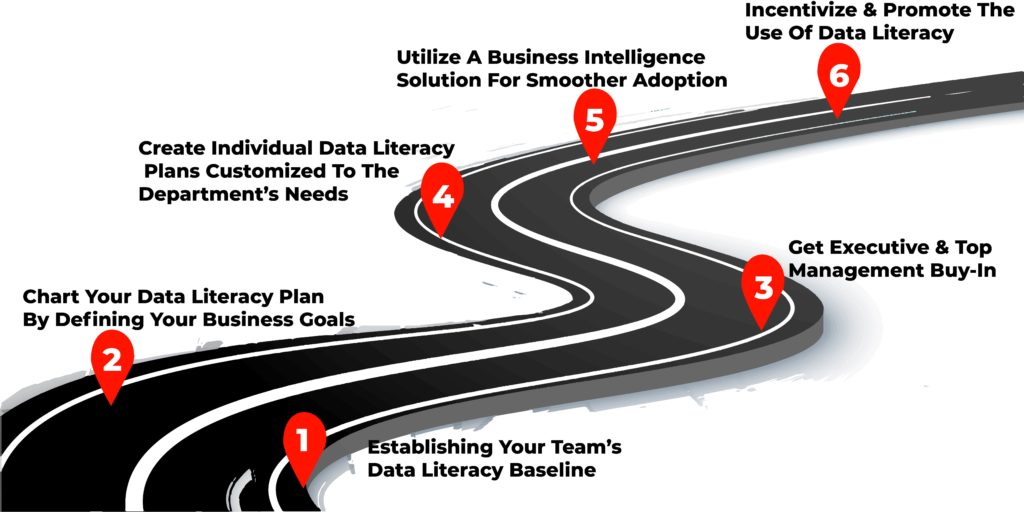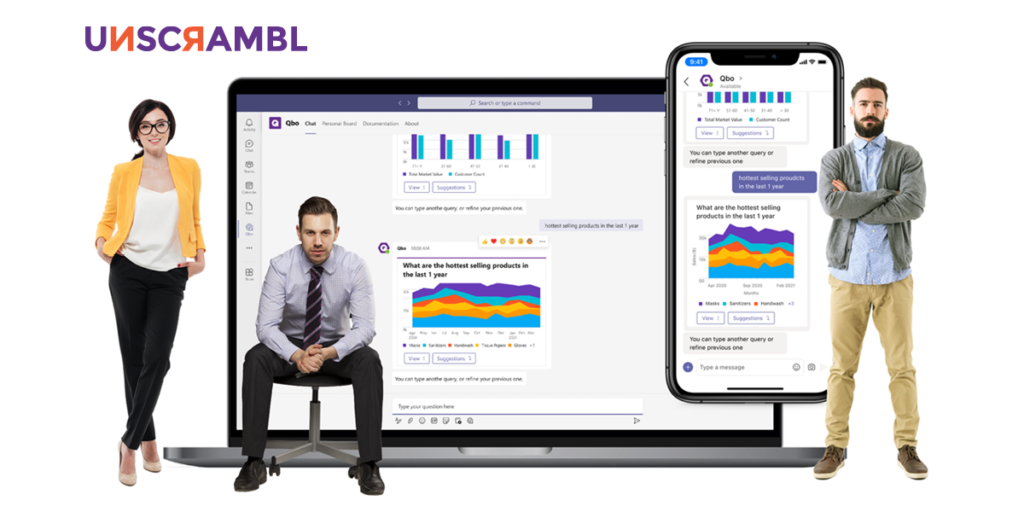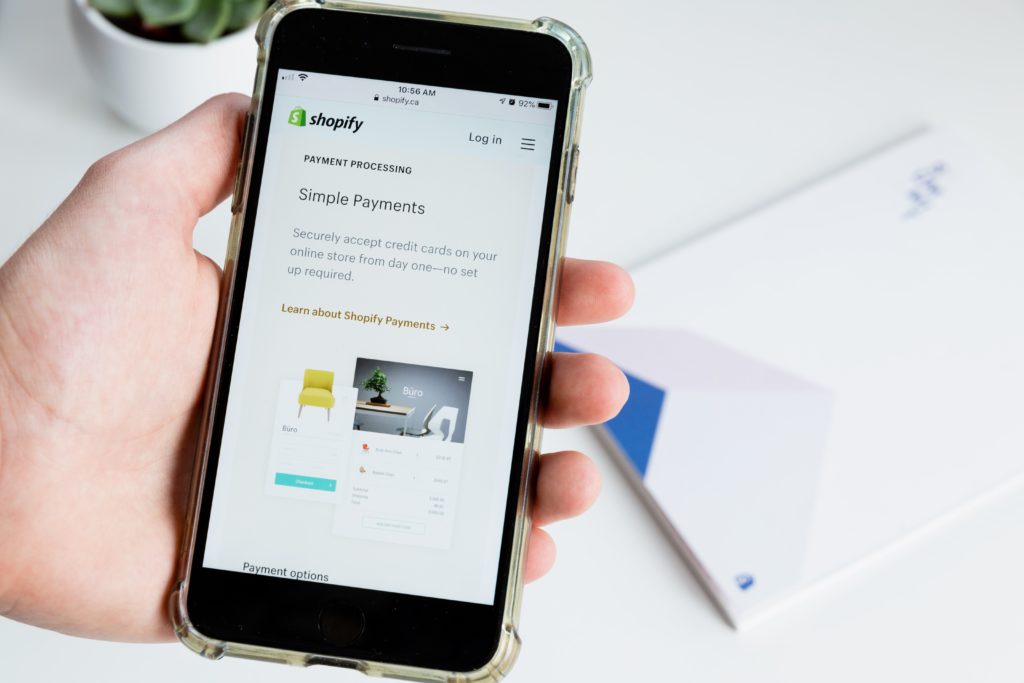 6 Minutes
6 Minutes

Data Literacy: Why It Matters & How To Develop One For Your Organization
Building a data-driven organization isn’t easy.
While establishing one allows businesses to better capture time-sensitive opportunities, optimize their operations and create more customer-centric experiences, it goes beyond just having the latest data analytics tool or a team of IT experts.
Based on a Gartner survey, an astounding 87.5% of enterprises had low BI & data analytics maturity – most of which fell into the basic categories that include spreadsheet-based analyses as well as opportunistic BI that were done for isolated stand-alone projects.
The biggest challenge facing organizations looking to embrace the power of data analytics is getting employees across every department educated and willing to utilize BI in their everyday work.
As Gartner also highlights, the three pillars of a lasting data-driven culture change involve:
- Identifying & communicating the business value of data
- Handling the impacts of a data-driven approach on work culture
- Managing the ethical implications of data and analytics
However, these presume that teams across an organization already understand how to effectively read, understand and utilize data in their daily work-life. Developing data literacy is a necessary precursor to the establishment of a data-driven culture.
In fact, Gartner projected that by 2020, 80% of organizations will start training their teams in the field of data literacy.
In this article, we will be taking you through why data literacy is mission-critical for every organization as well as how to develop an effective data-literacy plan and get started.
Why Data Literacy Is Essential For Every Organization
For an organization, data literacy is the ability for teams (and individual employees) to be able to read, analyze, utilize data as well as communicate the findings to stakeholders.
Data literacy enables the individual to effectively utilize data for cases and challenges that result in business value.
While the business intelligence and analytics market is projected to hit $27.4 billion in 2020, around 50% of organizations will not be able to derive business value from their BI tools due to the lack of data literacy.
Without widespread data literacy, organizations will have difficulty transforming their business in an age of rapid digitization where disruption is rampant across many industries.
This means the inability for your decision-leaders and teams to:
- Identify and capitalize on market trends
- Discover areas to optimize your business for both your staff and customers
- Uncover new revenue streams within the existing business
- Work collaboratively and more efficiently with data
- Innovate ahead and create new products that customers will love
Data literacy is one of the foundational aspects of fostering a data-driven culture, allowing business leaders and ground staff to make better informed data-driven decisions.
Through establishing data literacy in its organization and evolving into a data-driven company, American Express has fostered a culture of collaboration that helps to deliver better customer experiences and make accurate predictions.
This allowed American Express to build algorithms to attract new customers and boost existing retention rates with personalized offers. This helped their card-holders to save $100 million.
To become a data-driven organization, one of the first bricks to lay is establishing data-literacy that is effective and lasting.
Developing Your Data Literacy Plan (A 6-Step Guide)
1. Establishing Your Team’s Data Literacy Baseline
A data literacy survey done by Accenture found that over 9,000 employees across various roles found that a whopping 79% weren’t confident in their data literacy skills.
Knowing this, the first step is to audit the data literacy skills of your teams and employees. However, to do this effectively, it is key to remember that not all job roles require the exact same level of data literacy.
The decision-leader heading a department will naturally require higher data literacy in order to work with data analysts and data scientists to advise on the development of predictive models.
On the other hand, a simple ground staff at the retail store would just need to know the right data questions to ask to gain real-time insights to sell higher-margin products or to forecast orders to better keep the shelves stocked.
A great way to start is to take this free data literacy test and use it as a starting point to determine the different levels of data literacy of your employees.
2. Chart Your Data Literacy Plan By Defining Your Business Goals
Now that you have developed a baseline understanding of your organization’s data literacy, the next step is to define your business goals and map them to your data literacy expectations.
For example, if your goal is to use data to optimize revenue generation, you’ll want to define:
- The departments involved (in this case, likely the sales and marketing department)
- The leaders involved who will need more advanced data literacy skills
- The ground level staff who requires a working knowledge of data literacy
- An adoption time-frame to get familiar and run data trials and mini-projects
By leading with your business goals, you’ll be able to effectively lead your organization in a systematic way to close the data literacy divide while still scoring wins during the journey.
This helps to keep motivation high and accountability present as creating business value and hitting core KPIs are at stake.
3. Get Executive & Top Management Buy-In
Like how a general would articulate the big picture to the army, so must your management team to the rest of your organization.
Here are two quick ways to get started with this.
The first is to hold regular town hall meetings across the organization to go through and explain high-level business scenarios in a data-driven manner.
By explaining decisions made analytically and how breakthroughs were discovered through data-driven insights, management figures will be able to instill in employees the importance of data literacy and how every small effort helps the organization as a whole.
The second method is to have your Chief Data Officer (CDO) have regular meetings with department heads to better articulate the necessary data literacy requirements and expectations needed.
4. Create Individual Data Literacy Plans Customized To The Department’s Needs
Building data literacy consist of a variety of skills that include:
- Accessing and collecting data
- Managing data
- Data-driven inquiry and thinking
- Utilizing data management and analytical tools
- Data communication
Some of which might be necessary for a particular department, while some might be too overwhelming for other departments.
For example, while the retail store department might prize data communication and utilizing data management tools, less emphasis might be needed on data communication to key executives as the insights are mainly used to handle customer enquiries and issues.
The key here is to integrate data literacy into the work-lives of your employees and teams, weaving it into the existing culture of the department.
Cross-departmental data literacy programs can also be launched to give teams a holistic view of how data is being harnessed throughout the organization, allowing them to learn and absorb new frameworks without interfering with the necessary skills they first need to develop.
5. Utilize A Business Intelligence Solution For Smoother Adoption
One of the biggest stumbling blocks in establishing data literacy is the technical skills needed to analyze data and derive insights from them.
While softer thinking skills, such as data communication, can be imparted to employees over-time, not everyone can operate overly complex business intelligence tools.
However, this data democratization challenge can be easily solved by utilizing a business intelligence platform powered by conversational analytics.
With such a platform, users will be able to ask conversational questions to their data directly no matter the format or location of the data and gain insight within seconds.
This allows each individual to cut down the time needed to advance their data literacy on all fronts – from the setting up of cumbersome self-service BI dashboards to finding the right terms to communicate with the data.
6. Incentivize & Promote The Use Of Data Literacy
While learning data literacy skills in lectures or sharing sessions is a good start, they have limited effectiveness if the lessons aren’t applied daily.
One great way to continue fostering the culture of data literacy is to incentivize the use of data throughout their daily work.
For example, every group discussion or project should involve the use of data-driven insights presented in visualizations from the business intelligence solutions.
Another way is to allow employees to use their new-found data literacy skills to develop solutions to help the community or themselves – for example, using insights to help employees with their career development like how Google did it.
But more importantly, employees should not be discouraged from making mistakes when they are embarking on this journey of data literacy.
A framework of trial and error coupled with after-action assessments should be incorporated regularly to point out mistakes and to learn from them.
Accelerate Your Data Literacy Development With Qbo
At Unscrambl, we are committed to helping companies drive data analytics adoption and we believe that starts with establishing data literacy throughout your organization.
That’s why we developed Qbo, a business intelligence tool that allows users to ask questions directly to their data and obtain valuable insights instantaneously.
Give Qbo a try today, embark on a free 14-day trial and reach your data literacy goals faster.




